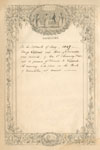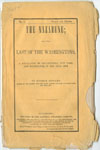George Lippard
George Lippard (April 10, 1822, to February 9, 1854). A wild Romantic journalist and novelist, he gave Philadelphia its sobriquet “The Quaker City.” He also gave it an extremely bad reputation with his best-selling novel of the same name. Lippard reveled in being a famous writer, and played this part to the hilt, carrying most times a sword-cane and a brace of loaded pistols, and staging his marriage on a rock in the Wissahickon at sunset.
Subtitled “The Monks of Monk Hall,” The Quaker City (1844) portrayed the city’s best men committing its worst crimes by night, every night. A proposed theatrical version of it in Philadelphia almost caused a riot. In 1845, after its viral success selling from newsstands made his novel a hit, he changed the dedication to Charles Brockden Brown.
Lippard’s other interests and obsessions included the mystic Germantown hermits, who had started their philosophical experiments in caves on the Delaware’s banks, and legends surrounding the American Revolution, some of his own invention, such as the apocryphal ringing of the Liberty Bell to herald Independence. He also tried out other Gothic sub-genres such as the Supernatural and Christian mysticism. Toward the end of his short life, he became an early labor leader, forming a secret society of working men that had tens of thousands of members across the country and survived into the 1980s.
Left: S.F. Earl. George Lippard. Oil on canvas. (Philadelphia, 1846). Historical Society of Pennsylvania Collection, Atwater Kent Museum of Philadelphia. For someone used to meager pay by the printed column-inch for his writing, George Lippard cut a dashing figure, sartorially and otherwise, in Philadelphia. He was utterly Byronic, self-consciously urbane, and usually armed. There was usually at least one dagger and one pistol under the colorful cloak he wore.
. . . Lippard was present, wrapped in an ample cloak, and carrrying a sword-cane to repel assault. He moved freely among the mob, without much care if he was seen or not. . . .
---From the account of the abortive opening of the theatrical version of The Quaker City in 1844; in John Bell Bouton’s Life of Lippard, 1855.
_______________________________________________________________________________________
 |
George Lippard. “The Rose of Wissahikon.” The Semi Annual Pictorial Saturday Courier. (Philadelphia, July 4, 1847), Historical Society of Pennsylvania.. Lippard loved the Wissahickon (which he spelled like nobody else), and here conflated its early hermetic lore with the Revolution. Obviously both gothic and historical fiction were big in the period, and made bigger still by their initial publication as serials in mammoth (two feet by three feet) newsprint periodicals like this. In this novel Lippard conjured the elaborate and still-prevalent myth of the Liberty Bell being rung to proclaim American Independence on July 4, 1776. (Bells weren’t rung to herald the Declaration until July 8.) The illustration rather oddly captures the moment just before the bell was rung. |
![Manufacturers including Whitehead & Hoag, of Newark, N.J. Insignia of the Brotherhood of the Union [later the Brotherhood of America]. (Philadelphia, and Newark, New Jersey, 1850-1882). Loaned by Dr. Neil K. Fitzgerald.](images/th4.3.jpg) |
Manufacturers including Whitehead & Hoag, of Newark, N.J. Insignia of the Brotherhood of the Union [later the Brotherhood of America]. (Philadelphia, and Newark, New Jersey, 1850-1882). Loaned by Dr. Neil K. Fitzgerald. George Lippard had been preoccupied with the rituals and regalia of a secret society for years before he launched the Brotherhood of the Union in 1849. He designed medals and badges with mystic symbols for its members, many of whom had presumptuous titles. Lippard himself was the “Supreme Washington.” The medal hanging from its own spange is the earliest known badge of the Brotherhood. The large copper emblem was likely a badge for general membership. Later, more elaborate designs enameled in colors held sway. It was Masonry for the workingman. |
|
|
[John Bell Bouton]. The Life and Choice Writings of George Lippard. (New York, 1855). Much of what we know of Lippard comes from this slim biography, written by an acquaintance the year after his death. This is one of a handful of known copies; two others formerly owned by Dr. Neil Fitzgerald are now in public collections.
|
![[John Bell Bouton]. The Life and Choice Writings of George Lippard. (New York, 1855).](images/thToastAm1855Lif-53445-O-1-pg95.jpg) |
[John Bell Bouton]. The Life and Choice Writings of George Lippard. (New York, 1855). Bouton’s biography includes this notorious after-dinner toast that Lippard gave at an Odd Fellows lodge in Virginia in 1852, in which he shows sympathy with both Northern abolitionists and the Southern gentlemen’s code of honor.. |
 |
George Lippard. Holograph letter to Andrew McMakin. (Philadelphia, November 7, 1853). Historical Society of Pennsylvania. In this letter to the editor of a literary newspaper, Lippard objected strenuously to being called a contributor to periodicals and promoted his craft as a “writer of books.” This was pretty much splitting hairs, since he earlier spent the better part of two-and-a-half years contributing American legends to the Courier, then edited by this same editor. |
 |
Brotherhood of the Union. B.G.C. I. Of the Circles of the Order. (Philadelphia, 1850.) Gift of the Brotherhood of the Union. |
 |
The Pictorial Bible. (New York, 1847.) Owned by George and Rose Lippard, the gift of the Brotherhood of the Union. After the Confederate states bolted the union, the name of the society needed some outreach work, and it was changed to the Brotherhood of America. At its height it had tens of thousands of members nationally, but by the 1980s it had dwindled to an insurance cooperative with only two dozen members. The last Supreme Washington wound it up in 1994 and gave some of the Brotherhood’s most precious relics to the Library Company, including some of their secret literature and Lippard’s Bible, with the record of his marriage to Rose Newman on a rock overlooking the Wissahickon at sunset on the eve of the new moon. |
 |
George Lippard. Paul Ardenheim, the Monk of the Wissahikon. (Philadelphia, 1848). Historical Society of Pennsylvania. A would-be recruit to the mystics haunting Philadelphia’s most romantic stream comes upon an alchemist who consecrates George Washington as the Deliverer prophesied in the Bible; but the hero is diverted from patriotic duty by a voluptuous demon-woman who lures him into her bedroom. In what might still be an understatement, Lippard stated proudly in his preface that he had written “the most improbable book in the world.” It may also be spiritually autobiographical: Lippard may have considered joining a Rosicrucian order before he invented a secret brotherhood of his own with many of the same rituals. |
 |
George Lippard. The Nazarene; or, The Last of the Washingtons, A Revelation of Philadelphia, New York, and Washington, in the Year 1844. (Philadelphia, 1854), Historical Society of Pennsylvania. |
 |
“By An Unknown Author [George Lippard]. The Ladye Annabel, or the Doom of the Poisoner, A Romance. (Philadelphia, 1844). Historical Society of Pennsylvania. |
 |
George Lippard. The Empire City; or, New York by Night and Day. (New York, 1850, here reprinted Philadelphia, 1864). |
 |
George Lippard. Washington and His Men. Being the “Second Series of the “Legends of the American Revolution.” (Philadelphia, 1849, reprinted here, 1864). Many of Lippard’s novels first appeared in paper wrappers, often with grabbing pictorial covers, and the same cover art continued to be used on new editions for decades. The Layde Annabel, his first Gothic novel, had all the usual European devices, like an Inquisitional “Doomsman” who scoops out victims’ eyeballs and pours in molten lead while they writhe. Lippard’s later efforts were homegrown blends of his favorite Gothic sub-genres – Christian mysticism folded into Patriotic hagiography, for instance. |
![“A Member of the Philadelphia Bar” [George Lippard]. The Killers, A Narrative of Real Life in Philadelphia. (Philadelphia, 1850). Historical Society of Pennsylvania.](images/th4.13.jpg) |
“A Member of the Philadelphia Bar” [George Lippard]. The Killers, A Narrative of Real Life in Philadelphia. (Philadelphia, 1850). Historical Society of Pennsylvania. |
![[George Lippard]. Life and Adventures of Charles Anderson Chester, The Notorious Leader of The Philadelphia “Killers.” (Philadelphia, 1850).](images/th4.14.jpg) |
[George Lippard]. Life and Adventures of Charles Anderson Chester, The Notorious Leader of The Philadelphia “Killers.” (Philadelphia, 1850). |
 |
George Lippard. The Bank Director’s Son, A Real and Intensely Interesting Revelation of City Life. (Philadelphia, 1851). Historical Society of Pennsylvania. Lippard based these three closely related novels on Philadelphia’s many street gangs and the riots they provoked, especially the 1844 Anti-Catholic Riots in Kensington and Southwark. Philadelphia had its own version of The Gangs of New York, organized around fire companies and reveling in names like The Rats, The Bouncers, and The Skinners. The “b’hoys” were toughs, but they dressed nattily, which may be why Lippard made his fictional gang leader Charles Anderson Chester a millionaire’s son and a Penn undergraduate. Displayed here are the only known copies of The Killers and The Bank Director’s Son. |
Click Here for Guide to Research on George Lippard (PDF) |
|

![[John Bell Bouton]. The Life and Choice Writings of George Lippard. (New York, 1855).](images/th4.4.jpg)